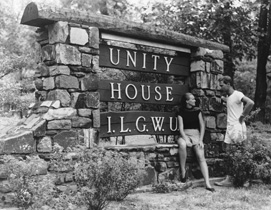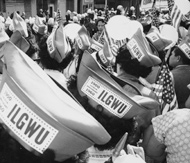

History of the ILGWU
Social Unionism

Throughout its history, and especially as it grew, the union did not limit itself to "bread and butter" issues. It also developed several elements of "social unionism," including arts and education, health care, housing, and recreation.
Local unions of the ILGWU established education departments as early as 1915. These presented a variety of course offerings to members, ranging from English language classes, to labor history classes, to visual and performing arts classes. In a 1944 letter to David Dubinsky about the workers' education movement, union organizer Rose Pesotta observed: "With labor's gains in the economic field, mental discipline and knowledge of history and economics become indispensable for unionists living and working in a democracy."1 The Educational Department of the international office also offered lectures and programs, sometimes holding them at the union-owned Unity House resort in Pennsylvania. Throughout the union's history, the ILGWU partnered with high schools and colleges to offer classes and trainings to members locally and nationally, and after 1957, provided scholarships for post-secondary education.
The ILGWU's first foray into providing health care to its members came with the establishment of the Union Health Center in New York City in 1913. Later, Union Health Centers opened in cities throughout the United States, and when it became clear that the services would benefit members who lived far from the centers, the ILGWU's Northeast Department began Mobile Health Units, trailers which would go to smaller towns and rural locations. The staff at these union health facilities provided check-ups, consultation, dental care, and prescriptions to union members across the United States. In 1969, the ILGWU launched a mail service prescription program for its members in the United State and Canada, and in 1976, extended the program to Puerto Rico.
As the ILGWU's membership grew in size and after its decision to permit investment of funds beyond federal bonds, the union expanded its reach to include housing. By the 1950s, the ILGWU and the United Housing Foundation were well-positioned to develop housing in New York City, for ILGWU members and other workers. Beginning in 1955 with the ILGWU Cooperative Village and later, Penn South in 1962, the union and its East River Housing Corporation sponsored affordable cooperative housing complexes. Architect Herman Jessor and Abraham Kazan of the United Housing Foundation were central figures in the development of the union's housing efforts, just as they had been earlier with the pioneering work of the Amalgamated Clothing Workers of America.

The ILGWU's first Unity House, a vacation destination away from the city, was a rented facility in the Catskills of New York. Beginning in 1919, the ILGWU's Unity House was located in the Pocono Mountains of Pennsylvania. The resort served as a relatively inexpensive getaway for union members and their families, and a meeting place for local unions and national labor organizations. The center included murals by Diego Rivera that provided a sweeping view of American history, and highlighted the struggles of workers. These murals and much of the structure were destroyed in a fire in 1969. Reconstruction of the grounds was completed by 1973, and Unity House remained in operation by the ILGWU until its closure in 1989.
1. Rose Pesotta, Bread Upon the Waters (Ithaca, NY: Cornell University Press, 1987), 15.


